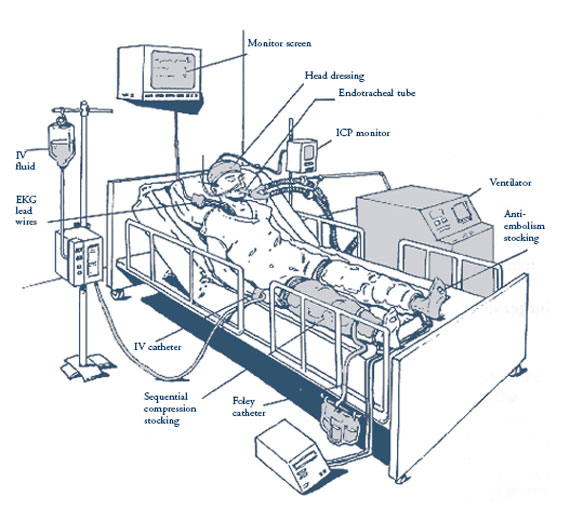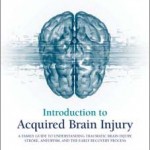While your loved one is in the intensive care unit, many different machines will be used to monitor their progress. The picture below shows the most common machines. If you have any questions about the equipment being used to care for your loved one, ask one of the ICU staff members.

The following are definitions of the ICU equipment pictured above.
• Monitor screen — a screen that displays the patient’s heart rate, breathing, blood pressure, and intracranial pressure.
• Head dressing — a bandage to keep the head injury or surgical incision clean and dry.
• ICP monitor — a small tube placed into or just on top of the brain through a small hole in the skull. It measures the amount of intracranial pressure inside the brain.
• EKG lead wires — wires connected to the chest with small patches that measure heart rate and rhythm.
• Nasogastric tube — a tube inserted through the nose and into the stomach that can be used to suction the stomach or provide liquid food into the stomach.
• Endotracheal tube — a tube inserted through the patient’s nose or mouth into the trachea (windpipe) to help with breathing and suctioning.
• Intravenous catheter (IV) and intravenous fluid — a flexible tube through which fluid, nutrients, and medicine are given.
• Ventilator – a machine that helps with breathing or breathes completely for a patient.
• Anti-embolism stockings (often called TEDS or TED hose) — long white stockings which help prevent blood clots from forming in the legs.
• Sequential compression stockings (also called SCD hose) — plastic leg wraps that inflate and deflate to help prevent blood from pooling in the legs.
• Foley catheter — a drainage tube from the bladder that allows urine to be collected and measured.
 Brain Injury: A guide for family and friends
Brain Injury: A guide for family and friends
Table of Contents
• What is a Brain Injury?
• How Bad Is It?
• How the Brain Functions
• Common Problems During Early Recovery
• The Intensive Care Unit (ICU)
• Understanding Coma
• How Does an Injured Brain Heal?
• How You Can Help With Recovery
• Where Will the Journey Go From Here?
• How Will I Ever Get Through This?
• Where to Go for Help
• Books for Families Coping With Brain Injury
